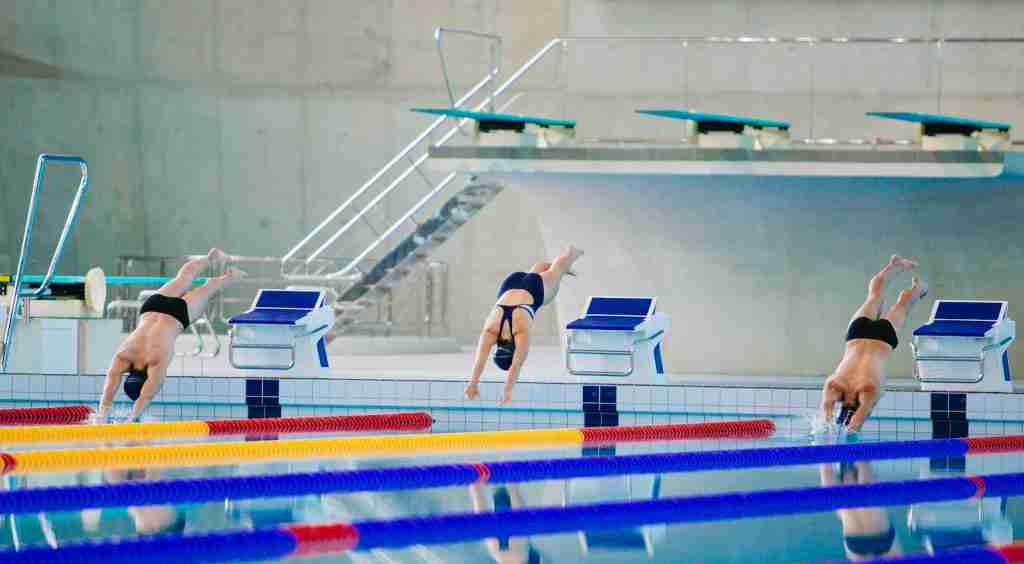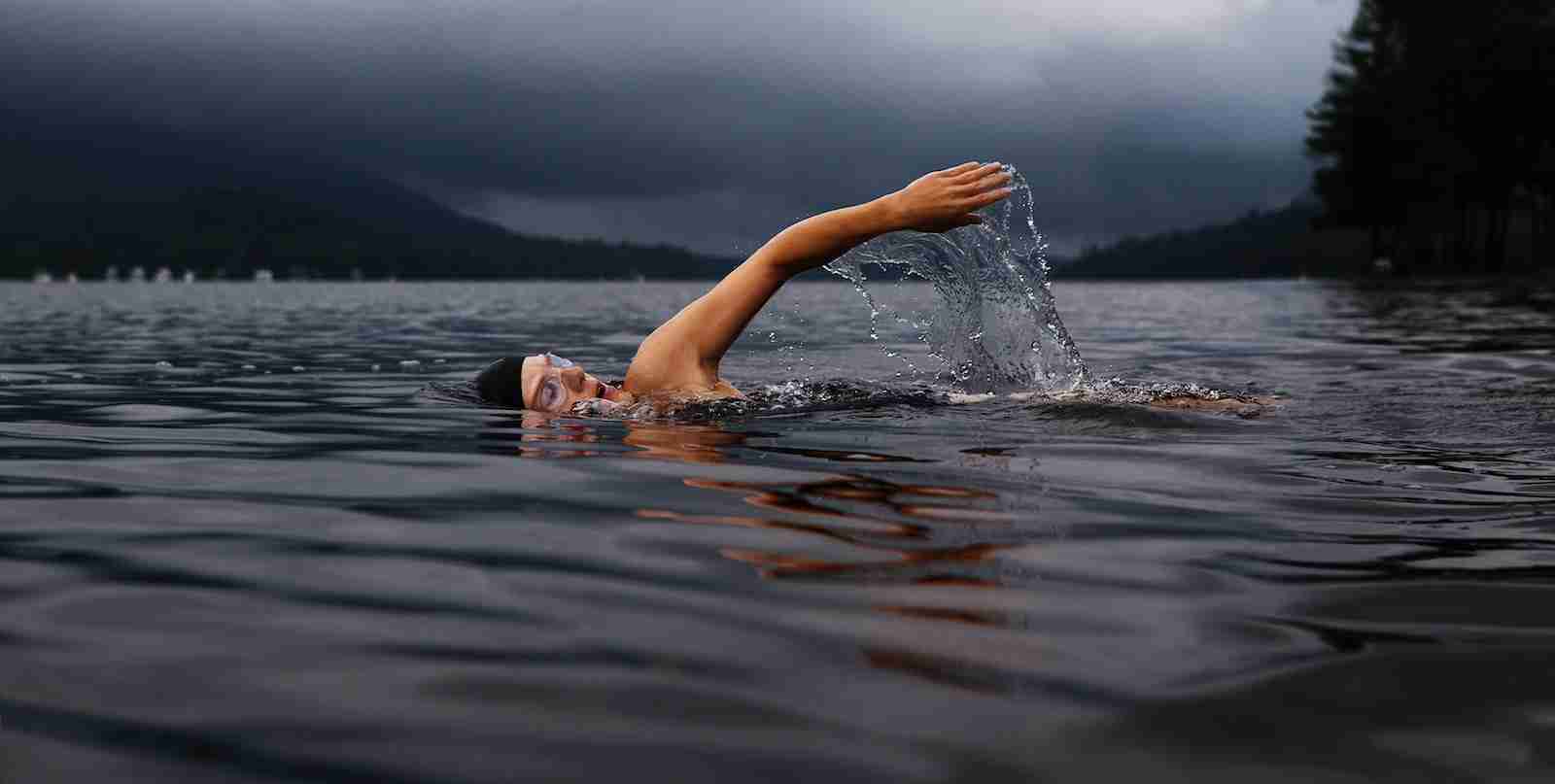22 Fun Facts About Swimming You Must Know
1. Swimming is one of the oldest sports in history.
Throughout the centuries, humans have been drawn to water for various reasons, and swimming has been an essential skill and recreational activity.
From ancient civilizations to modern times, swimming has evolved from a survival necessity to a competitive sport enjoyed by millions worldwide.
2. The average person can swim about 2 miles per hour.
While swimming speed varies depending on factors such as technique, fitness level, and experience, the average person can comfortably maintain a speed of approximately 2 miles per hour.
Of course, trained athletes and professionals can achieve much faster speeds, but this serves as a general benchmark for the average swimmer.
3. The breaststroke is the oldest known swimming stroke.

Breaststroke, Humanity’s Oldest Swimming Stroke.
Among the various swimming techniques, the breaststroke holds the distinction of being the oldest known stroke. Its origins can be traced back to ancient civilizations, with depictions found in Egyptian murals dating back thousands of years.
The breaststroke remains popular today and is often one of the first swimming styles taught to beginners, which is one of the fun facts about swimming.
4. Dolphins are excellent swimmers and can reach speeds up to 20 miles per hour.
These marine mammals have evolved to excel in their aquatic environment, capable of reaching speeds of up to 20 miles per hour.
Their streamlined bodies, powerful tails, and natural buoyancy contribute to their incredible swimming abilities, making them a captivating sight in oceans and seas around the world.
5. Competitive swimming became an Olympic sport in 1896.
The first modern Olympic Games, held in Athens, Greece, included swimming events, marking the beginning of competitive swimming’s prestigious status on the global stage.
Since then, swimming has remained a core discipline in every subsequent edition of the Olympics, captivating audiences with its intense competitions and remarkable athletes.
6. The butterfly stroke is the most exhausting swimming stroke.
Characterized by a symmetrical arm movement combined with a dolphin-like undulating body motion, the butterfly stroke requires immense strength and endurance. Fun Facts About Swimming: Swimmers who specialize in this stroke must possess exceptional upper-body power, core stability, and cardiovascular fitness to sustain the rigorous demands of the stroke.
Despite its challenging nature, the butterfly stroke has become a captivating spectacle in competitive swimming, showcasing the remarkable athleticism and grace of its practitioners.
7. Michael Phelps, an Olympic swimmer, has won the most gold medals in history.

with Most Gold Medals Ever!
This American swimmer, widely regarded as one of the greatest athletes of all time, has achieved unparalleled success in the Olympic Games. Throughout his career, Phelps has amassed a staggering total of 23 gold medals, making him the most decorated Olympian in history.
His remarkable achievements have not only elevated the sport of swimming but also inspired countless aspiring athletes to strive for excellence in their chosen disciplines.
8. swimming can burn up to 650 calories per hour.
If you’re looking for a way to stay fit and burn calories, swimming offers a fantastic solution. Not only is it a refreshing and enjoyable activity, but it also provides an excellent full-body workout. Swimming engages multiple muscle groups simultaneously, making it a highly effective cardiovascular exercise.
This makes it a popular choice for individuals seeking to improve their fitness levels, manage their weight, or simply engage in a low-impact exercise that is gentle on the joints.
9. The fastest recorded swim speed is 5.34 miles per hour.
One of the fun facts about swimming is that it is a sport that demands speed and efficiency in the water. Over the years, athletes have pushed the limits of their abilities to achieve remarkable swim speeds.
This record showcases the incredible athleticism and skill required to move through the water at such a rapid pace. Swimmers continue to strive for even greater speeds, constantly pushing the boundaries of what is possible in the world of competitive swimming.
10. The first indoor swimming pool in the United States opened in 1868.
Swimming as a recreational activity has a rich history, and the United States played a significant role in its development. This marked a major milestone in the accessibility and popularity of swimming as a pastime. Indoor pools provided individuals with the opportunity to swim year-round, regardless of the weather conditions.
The opening of the first indoor swimming pool in the United States laid the foundation for the proliferation of swimming facilities throughout the country.
11. Swimming can help improve cardiovascular health and build muscle strength.
Beyond its competitive aspect, swimming offers numerous health benefits. The combination of aerobic exercise and water resistance places a moderate strain on the heart and lungs, promoting their overall fitness.
Swimming engages various muscle groups throughout the body, making it an excellent form of full-body exercise. The resistance provided by the water helps build muscle strength, endurance, and tone. Swimming is a low-impact activity that is gentle on the joints, making it suitable for individuals of all ages and fitness levels.
12. The crawl stroke, also known as freestyle, is the fastest swimming stroke.
Swimmers utilize a combination of strong-arm strokes and flutter kicks to propel themselves through the water with speed and efficiency which is one of the fun facts about swimming. The crawl stroke’s emphasis on continuous and rhythmic movements allows swimmers to maintain a steady pace over long distances.
The technique’s effectiveness is reflected in its popularity among competitive swimmers and its adoption as the primary stroke in freestyle events. Mastering the crawl stroke requires a balance of power, technique, and endurance, making it a challenging yet rewarding skill to develop.
13. The largest swimming pool in the world is the San Alfonso del Mar pool in Chile.
It is located in Algarrobo. This magnificent pool stretches over an incredible area and is filled with seawater from the nearby Pacific Ocean.
Its vast size makes it perfect for various water activities and provides an unparalleled experience for visitors and swimmers alike.
14. Floating in water can help relax muscles and reduce stress.
The gentle support of the water relieves pressure on joints, promoting a feeling of calmness and relaxation, making it an excellent way to unwind and alleviate tension after a long day.
15. Swimmers can experience a higher lung capacity due to regular breathing techniques.
Mastering proper breathing while swimming helps increase the oxygen intake, training the lungs to work more effectively.
This improvement in lung capacity enables swimmers to excel in their performance and endurance, making them more capable of tackling challenging distances and strokes.
16. In 1900, women were allowed to compete in swimming events at the Olympics for the first time.
This marked a significant step towards gender equality in sports, granting female athletes the opportunity to showcase their talents on the international stage.
Since then, women’s participation in swimming competitions has grown tremendously, inspiring generations of female swimmers worldwide.
17. Swimming goggles were first used in the 14th century by Persian pearl divers.
These early goggles were made from tortoise shells and had two glass lenses to protect the divers’ eyes from water and debris. The use of swimming goggles by pearl divers helped them to see clearly underwater, making their work more efficient and safer.
Over time, the design and materials of swimming goggles have evolved, and today they are an essential accessory for swimmers of all levels.
18. Swimming can help improve flexibility and increase range of motion.
Swimming, which offers a myriad of benefits, including Fun Facts About Swimming, involves repetitive movements and stretching that effectively work various muscle groups, promoting flexibility and joint mobility. The resistance of the water against the body also helps to gently stretch and elongate the muscles.
Regular swimming can lead to improved flexibility, allowing swimmers to move more freely both in and out of the water.
19. The human body is more buoyant in saltwater than in freshwater.
Due to the higher salt content in seawater, it provides greater buoyancy to the human body compared to freshwater. This buoyancy reduces the overall weight and impact on the body, making swimming in the ocean or saltwater pools feel lighter and more effortless.
It also allows swimmers to float more easily on the surface, enhancing their comfort and relaxation in the water.
20. Swimming can improve coordination and balance.

and Balance with Swimming!
Swimming, known for its numerous benefits, also offers a collection of intriguing Fun Facts About Swimming. It requires the synchronization of various muscle groups and movements, promoting overall coordination. It involves the coordination of arm and leg movements, breathing techniques, and body position in the water.
This constant coordination helps to improve balance and proprioception, the body’s awareness of its position and movement. Regular swimming can enhance these skills, leading to better coordination and balance in daily activities as well.
21. Swimming can help relieve symptoms of asthma and improve lung function.
The moist environment of a pool can help reduce the risk of asthma attacks, and the warm temperature can relax and open up the airways. Swimming requires controlled breathing techniques, which can improve lung capacity and strengthen respiratory muscles.
Regular swimming sessions may contribute to better management of asthma and promote overall respiratory health.
22. What are some swimming health benefits?
Swimming has many health benefits. It’s a low-impact exercise that’s easy on the joints. It improves cardiovascular health, helps manage weight, and builds muscle strength. Swimming also enhances flexibility and reduces stress.
Plus, it’s a lifelong activity that’s enjoyable and refreshing.
FAQs
Swimming is most popular in various parts of the world, particularly in countries with a strong emphasis on aquatic sports and leisure activities. Places like Australia, the United States, Canada, and several European countries have a significant swimming culture. These locations often have well-developed swimming facilities, competitive swimming programs, and a high participation rate among the general population.
Swimming can indeed bring happiness to many individuals. It is often considered a refreshing and enjoyable activity that offers numerous physical and mental benefits. Being immersed in water can provide a sense of relaxation and tranquility, and the rhythmic movements involved in swimming can have a calming effect on the mind.
A group of swimmers is commonly referred to as a team or a squad. Swimmers often come together to form teams for competitive purposes, such as representing their schools, clubs, or countries in swimming competitions. These teams usually have coaches and trainers who guide and oversee the swimmers’ training and performance.
Determining the best place to swim depends on personal preferences and the specific qualities one seeks in a swimming experience. Many people consider natural bodies of water, such as pristine beaches, crystal-clear lakes, or serene rivers, as the best places to swim due to their scenic beauty and the opportunity to connect with nature. Others may prefer well-maintained swimming pools with modern amenities and lifeguard supervision, which provide a controlled and safe environment for swimming.
There are several different types of swimming recognized worldwide. The most common and well-known type is freestyle, also known as front crawl, where swimmers move their arms alternately in a windmill-like motion while kicking their legs. Other prominent swimming styles include breaststroke, backstroke, and butterfly stroke. Each style has its own set of techniques and rules for competitive swimming.







